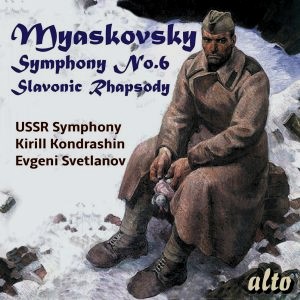

Slavonic Rhapsody in D minor, Op. 71 (Evgeni Svetlanov - conductor) Symphony No. 6 in E flat minor, Op. 23 (Kirill Kondrashin - conductor)
Not all reissues are created equal. Some are absolutely non-essential while others, like this one, are of great musical and historical importance. The original recording of the Symphony No. 6 in E flat minor, Op. 23 dates back to 1959 and was issued on the Russian Disc label. The original recording of the Slavonic Rhapsody in D minor, Op. 71 on the other hand was released on the Olympia CD label. Two labels that are now inoperative which would make it difficult for anyone interested to obtain any of these recordings. But thanks to labels like Alto (Musical Concepts) who obtain the licensing rights to these valuable recordings, re-master and reissue them, they become accessible again. Alto are responsible for the reissue of this definitive recording of the Symphony No. 8 by Dmitri Shostakovich, as well as many more older recordings of artistic significance.
Nikolai Yakovlevich Myaskovsky (1881-1950) who was born near Warsaw and died in Moscow, was often referred to as the "Father of the Soviet Symphony". During the 1940s, despite having been awarded the Stalin Prize on five occasions, he was, along with Prokofiev, Khachaturian and Shostakovich, denounced for writing anti-Soviet music. Amongst other works, he composed a total of 27 Symphonies, a Violin Concerto, Cello Concerto, 13 String Quartets and many works for piano including 9 Sonatas.
This 1923 Sixth Symphony (rev. 1947), is the only one of the 27 which incorporates a choral segment as part of the final movement. The text is from a poem depicting the soul looking down at the body it has just discarded. The booklet notes point out that "the theme of death undoubtedly pervades the symphony". The opening movement launches with a great cry of anguish, but as the music progresses, swells of energy gather around a main theme proclaimed for the most part by trumpets. A brief moment of peaceful respite appears before the movement ends cloaked in dark mystery. The highly agitated scherzo second movement does little to lighten the mood despite its rather serene and untroubled central passage, which returns very briefly near the end only to be abruptly shut down. The slow Andante appassionato reaffirms the first movement's dark atmosphere, but with a tone now of sadness rather than anger, and even passages of reassuring beauty which bring the movement to a close. The opening pages of the final movement sound like the dawn of Christmas day, full of light and promise. But again agitation and apprehension quickly set in, including a subtle intonation of the Dies Irae, a clear symbolic reference to death, all of it counter-balanced by the inclusion of French revolutionary anthems. The choir steps in with its words of loss, and the whole symphony ends on a blissful note. The booklet notes hint at the idea that the work may have been a symbolic farewell to Old Russia.
I must say that Paul Arden-Taylor who did the re-mastering for Alto did a fantastic job, because for a 60 year old recording it certainly doesn't sound its age.
Jean-Yves Duperron - April 2020